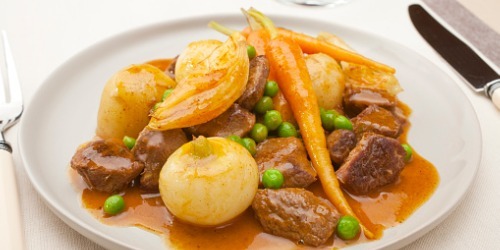What Adam Smith Ate (& Drank!): Claret
May 15, 2023

"Smith’s use of wine to demonstrate everything from supply and demand, costs of goods, duties, and tariffs arguably made him the first wine economist tracking values, appreciation, and retail prices."

"Smith’s use of wine to demonstrate everything from supply and demand, costs of goods, duties, and tariffs arguably made him the first wine economist tracking values, appreciation, and retail prices."
In our discussions of what Adam Smith ate, we’ve spent very few words on what Adam Smith drank, specifically his wine of choice, a good French claret, the name for wine from the Bordeaux region. It’s what, today, we would call, simply Bordeaux.
Located on the western coast of France, the city and port of Bordeaux sits at the mouth of the Gironde estuary created by the confluence of the Dordogne and Garonne rivers. The vineyards spread along both sides of the rivers creating what is – today – the largest wine growing region in France.
Bordeaux and its wines had a long history with England centuries prior to Smith’s time. Since the Middle Ages and Eleanor of Aquitaine, the region had been under some form of English control. Under the Plantagenet kings, wines from the region became the favorites of English kings. By 1302, the Bordelaise exported claret in large quantities to England for the royal tables.
In the 16th century, Dutch merchants and landowners drained swamps to build roads which resulted in significant amounts of new available land, perfect for even more vineyards. With the high demand of Bordeaux’s wines, both French and English merchants made vast fortunes. The new roads and ports meant more wine could be shipped by sea faster to avoid spoilage.
Because of its convenient location as a major port, Bordeaux’s hearty clarets were popular and easy exports. Even in the 18th century, grape growers in Bordeaux favored what we today would call Cabernet Sauvignon, Merlot, Cabernet Franc, and other varieties.
By the time Adam Smith was of drinking age, merchants supplied Scotland and England with as much of the hearty French claret as their ships could carry. We know that Smith and his young ward, the Duke of Buccleuch, spent time in Bordeaux while living in Toulouse in the mid-1760s. Both cities had their own governing bodies (of great interest to Smith) and their own well-connected officials. Bordeaux had been home to several Enlightenment scholars including Montesquieu (and his equally brilliant son, who Smith stalked just a little.)
Wine was an important part of everyday life – one that factored into An Inquiry into the Nature and Causes of the Wealth of Nations. In fact, Smith’s use of wine to demonstrate everything from supply and demand, costs of goods, duties, and tariffs arguably made him the first wine economist tracking values, appreciation, and retail prices. French wine was subject to hefty duties in England and the time, which only made it more desirable to those who could afford it.
Today, bottles are often labeled “claret” to show they contain a blend of red grapes popular in the Bordeaux region and some affordable bottles can be found in California. Whether called claret or Bordeaux, this hearty red wine pairs well with roasted meat – especially beef and lamb. Smith and his friends would have enjoyed many bottles during dinners to help the conversation and ideas flow, perhaps with a lamb stew filled with spring vegetables like this one.
Lamb Stew with Spring Vegetables
5 lb lamb leg roast (or lamb shoulder roast), cubed with fat and excess connective tissue removed
2 tbsp vegetable oil
2 tbsp butter
¼ cup all-purpose flour
1 28-oz can diced tomatoes
4 cups beef stock
2 cups water
2 tsp dried herbs de Provence or a mixture of fresh rosemary, thyme, and bay leaf
2 lbs root vegetables such as potatoes, turnips, or rutabegas, peeled and cut into 1-inch pieces
1 lb carrots, peeled and cut into 1-inch pieces
1 cup spring peas (fresh or frozen)
Salt and pepper
1. Preheat the oven to 450F.
2. Heat the oil and butter in a large Dutch oven or casserole over medium heat. Brown the lamb pieces in batches, letting them develop a nice crust. When finished, return to the Dutch oven.
3. Sprinkle the flour over the meat and stir through to coat each piece. Salt and pepper the meat thoroughly. Bake in the preheated oven, uncovered, for 5 minutes. Stir, then bake for another 5 minutes. Remove to the stove top and turn the oven down to 350F.
4. On the stove top, over medium heat, add the tomatoes, stock, water, herbs, salt and pepper. As Stir to combine and also to scrape up the browned bits on the bottom of the pan. Bring to a simmer.
5. Cover, and put the stew in the oven for 1 hour.
6. Remove, and add the root vegetables and carrots. Return to the oven for 45 minutes. (Check for the meat’s tenderness and give more time if needed.)
7. In the meantime, cook the peas and any additional spring vegetables you might like to add separately. Add them at the end and stir to combine. Ladle the lamb stew into bowls and serve with crusty bread and a glass of hearty Bordeaux.
Thirsty for more?
Renee Wilmeth's What Adam Smith Ate (& Drank!): Claret, Part 2
Previous posts in our "What Adam Smith Ate" series
Sarah Skwire's Free Trade in Language: Adam Smith on Words and Wine
Adam Smith on Good Wine and Free Trade
WealthofTweets on Taxes in the Wealth of Nations (on Twitter) and here (on ASW)
Renee Wilmeth's What Adam Smith Ate (& Drank!): Claret, Part 2
Previous posts in our "What Adam Smith Ate" series
Sarah Skwire's Free Trade in Language: Adam Smith on Words and Wine
Adam Smith on Good Wine and Free Trade
WealthofTweets on Taxes in the Wealth of Nations (on Twitter) and here (on ASW)